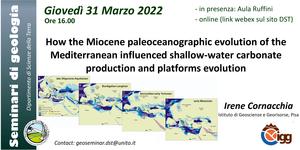How the Miocene paleoceanographic evolution of the Mediterranean influenced shallow-water carbonate production and platforms evolution - Dr. Irene Cornacchia (giovedì 31 marzo in Aula Ruffini DST e via Webex)
Da: Giovedì 31 marzo 2022 ore 16:00
Fino a: Giovedì 31 marzo 2022 ore 17:00

Miocene is a key interval in the global climate evolution, as well as in the geodynamic evolution of the Mediterranean basin, that acquired its actual physiography during this time. Both global climate and regional geodynamics affected Miocene Mediterranean paleoceanographic evolution, which in turn controlled carbonate production changes.
This seminar will show the paleoceanographic evolution of the Miocene Mediterranean reconstructed from Sr and Nd isotope records of different shallow-water and hemipelagic successions. Secondly, shallow-water carbonate production changes will be presented and discussed, framing them in the complex Miocene global climate and regional paleoceanographic framework.
This integrated approach shows that, during the Aquitanian, the Mediterranean was a wide and open basin, mainly fed by the Indian Ocean and characterized by a westward circulation. In this context, carbonate ramps were dominated by Larger Benthic Foraminifera, while coral carpets or mounds occurred in the lower portion of the middle ramp, in the oligophotic zone.
With the closure of the Indian connection in the late Burdigalian, the overall circulation of the Mediterranean changed, leading to higher residence time of waters. This new oceanographic regime made the Mediterranean more sensitive to regional controlling factors, such as volcanism, on seawater chemistry. The Indian Gateway closure affected Larger Benthic Foraminifera the most. They, in fact, show a demise after the late Burdigalian and carbonate ramps started to be dominated by red algae and bryozoans, which spread in particular during the Monterey Event. From the Tortonian to the early Messinian, small sub-basins, characterized by restricted circulation, developed in the Eastern and Central Mediterranean, as attested by the deviation of local Sr isotope records from the global ocean. From the late Tortonian to the early Messinian, reef complexes and fringing reefs developed in the Western and Central Mediterranean, with the exception of these small sub-basins, such as the proto-Adriatic one, where red algae and small benthic foraminifera persisted.
Speaker: Dr. Irene Cornacchia
Irene Cornacchia studied at the “Sapienza, University of Rome” where, in 2018, she obtained her PhD in Earth Sciences with a thesis entitled: “The impact of isotopic events on the Central Mediterranean carbonate successions between late Eocene and Miocene”.
After a one-year post-doc at the GeoZentrum NordBayern of the Friedrich-A¬lexander University of Erlangen (Germany), Irene became a researcher at the Institute of Geosciences and Earth Resources of the Italian National Research Council (IGG-CNR), where she currently works. Irene’s main research topic is how Mediterranean carbonate systems responded to major climate changes and carbon cycle perturbations during the Cenozoic. Through a multidisciplinary approach based on facies and microfacies analyses, as well as isotope geochemistry of stable (C and O) and radiogenic isotopes (Sr and Nd), she focuses on the complex relationships between global climate trends and regional factors (geodynamics and paleoceanography) that controlled carbonate production changes and demises.
Contact: geoseminar.dst@unito.it





